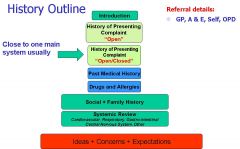![]()
![]()
![]()
Use LEFT and RIGHT arrow keys to navigate between flashcards;
Use UP and DOWN arrow keys to flip the card;
H to show hint;
A reads text to speech;
13 Cards in this Set
- Front
- Back
|
Describe the order that a clinical history should be taken
|

|
|
|
Describe how to take a history in order
|
1. Introduce self
2. Get consent for questions and writing notes 3. Ask what preferred to be called 4. Check name if necessary, age, sex, referral details 5. History of presenting complaint (SQITARS if pain) 6. Appropriate system review 7. Any current diagnoses 8. Past medical history 9. Any major operations and reaction to anaesthetic 10. Social history - Who lives with - Who can care / children etc - Occupation or past occupation (exposure to hazards) - Needs (e.g. mobility/continence) - Smoking history (current or ex-smoker and what smoked) - Alcohol units per week - Recreational drugs - Travel history 11. Medication and diets (specify route if non-oral, drug, dose, frequency, medical indication and consider over-the-counter and homeopathic remedies) 12. Allergies (NKDA) 13. Family history 14. Systems review 15. ICE 16. Any questions 17. Thanks |
|
|
History of presenting complaint - what questions do you ask for pain?
|
SOCRATES
- Site - Onset - Character - Radiation - Symptoms associated - Time course - Exacerbating/relieving factors - Severity |
|
|
What diseases are covered in past medical history?
|
- Myocardial infarction
- Angina - Stroke - Deep vain thrombosis/ pulmonary embolism - Endocrine disease (e.g. hyperthyroid) - Epilepsy - Jaundice / TB / Rheumatic Fever - Peptic ulcer - Hypercholesterolaemia - Hypertension |
|
|
How do you calculate pack years?
|
Number of cigarettes per day x number of years / 20
|
|
|
What is 1 alcohol unit and what classifies binge drinking?
|
1 unit =
- 1/2 pint normal strength beer, cider, or lager - 25 ml or pub measure of spirits - 50mls fortified wine e.g. sherry |
|
|
Systems review: CVS
|
- Chest pain
- Dyspnoea / paroxysmal nocturnal dyspnoea (PND) - Oedema (swelling) - Palpitations - Others (e.g. peripheral vessel disease) |
|
|
Systems review: RS
|
- Cough
- Sputum - Haemotypsis - Chest pain - Wheeze - Dyspnoea - Others e.g. Exercise tolerance (meters / miles) |
|
|
Systems review (GIT)
|
- Chewing / swallowing problems
- nausea - vomiting/ haematemesis - heartburn - weight loss - jaundice - abdominal pain - diarrhoea / constipation - bleeding PR - Others |
|
|
Systems review (GUT)
|
- Haematuria
- Burning/scalding - Frequency - Hesitancy - Incontinence - Others (e.g. nocturia) |
|
|
Systems review (CNS)
|
- Headaches
- Blackouts - Dizziness - Weakness - Depression - Anxiety - Visual problems - Other (e.g. coordination problems) |
|
|
Systems review: Locomotor
|
- Stiffness in joints
- Joint pain - Swelling - Rashes - Locking of joints |
|
|
Systems review: Gynae
|
- Last period
- Pregnancy? - Presentation of normal period - regularity, heaviness etc |

